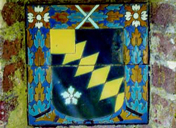HOUSE AND ESTATE
HISTORY
19th and early 20th centuries
Victorian influence
In 1826, the house became the home of Edward Austen Knight's son, also Edward, who carried out extensive work on the estate, building a new Servants Hall, a Billiard Room wing and replacing some of the wooden sash windows with stone casements. On his death the title passed to his son Montagu who spent considerable amounts of time and money continuing the restoration and modernising of the house, with the influence of Edwin Lutyens being apparent in many areas. As Montagu was childless, his nephew, Lionel, inherited the estate, followed by his son Edward Knight III. Inheritance taxes and increased running costs following the war then started a long period of decline, the sale of most of the outlying manor and the subdivision of the house into flats.

A message written by Montagu Knight on All Saints Day 1868, found in a bottle under the floorboards in the Great Hall during the restoration.

Tile of the Knight coat of arms, set in the wall of the Upper Terrace, built by Montagu Knight in 1901
